Barely a year after firing GM Jon Robinson, Amy Adams Strunk pulled the plug on the second high-profile staff extension she authorized back in 2022. Firing Mike Vrabel does not bring a full-on reset for the Titans, but the owner has given GM Ran Carthon the keys. The second-year decision-maker set out to load up his roster around Will Levis‘ rookie contract, leading to some high-priced free agency moves.
As the Titans look to pick up the pieces following a down (and injury-riddled) past two seasons, they also said goodbye to one of the greatest players in team history. With Derrick Henry gone, the Titans — who fired Robinson in December 2022 — have stripped their offense of nearly all the previous GM’s investments. This is Carthon’s show now, and the Titans will attempt to justify their Levis confidence this season.
Coaching/front office:
- Fired Mike Vrabel after six seasons, hired Brian Callahan as HC replacement
- Added Jaguars’ Nick Holz as offensive coordinator, Ravens’ Dennard Wilson as DC
- GM Ran Carthon now holds full roster control; team promotes Chad Brinker to president of football ops
- Browns let Bill Callahan out of contract, allowing him to join son as Titans’ O-line coach
- Retained Vrabel staffers Chris Harris, Justin Outten
- Hired Raiders interim OC Bo Hardegree, requested HC interview with Antonio Pierce
The Vrabel-Carthon-Adams Strunk partnership soured fast. Although Carthon said he was not in the meeting when Adams Strunk decided to fire Vrabel, the GM benefitted in the form of full roster control. Vrabel had maximized some moderately well-regarded Titans rosters, leading the team to four straight winning seasons and three playoff berths. Tennessee was believed to have a trade chip due to Vrabel’s standing in the game, but in not wanting to see trade talks impede an immediate coaching search, Adams Strunk went through with a much-discussed firing.
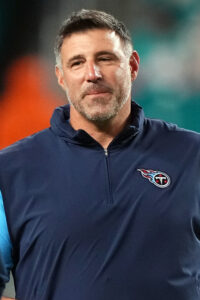 Adams Strunk had signed Vrabel and Robinson to extensions shortly after the 2021 season; she will be paying two HCs and two GMs for the foreseeable future. For all of Vrabel’s accomplishments — which includes a Coach of the Year honor, an AFC championship game venture, two division titles and a No. 1 seed — he butted heads with the team’s owner last season.
Adams Strunk had signed Vrabel and Robinson to extensions shortly after the 2021 season; she will be paying two HCs and two GMs for the foreseeable future. For all of Vrabel’s accomplishments — which includes a Coach of the Year honor, an AFC championship game venture, two division titles and a No. 1 seed — he butted heads with the team’s owner last season.
Carthon’s role became an issue for the coach, who suggested to Adams Strunk she name the ex-49ers exec assistant GM. Vrabel preferred former interim GM Ryan Cowden. This surely did not go over well with Carthon, even though he attempted to distance himself from the firing (however, a report of a rift surfaced late last year). Adams Strunk also considered firing Vrabel after the 2022 season, and she balked at the HC’s request for roster control.
Not exactly pleased with Vrabel’s trip to Foxborough during the Titans’ bye week last season (to be inducted into the Patriots Hall of Fame), Adams Strunk took a risk by jettisoning one of the NFL’s most respected leaders. But Vrabel’s inability to land another HC job during this year’s cycle undoubtedly affected his stock. He will join ex-mentor Bill Belichick on the 2025 coaching carousel. At 49, Vrabel may have a better chance of landing another gig.
The Titans’ Pierce effort did not get off the ground, and Callahan — after five seasons as a non-play-calling OC — became the pick soon after. An extension of the Sean McVay coaching tree (due to being a Zac Taylor lieutenant), Callahan played a central role in a Bengals ascent that included back-to-back AFC championship game appearances for the first time in franchise history.
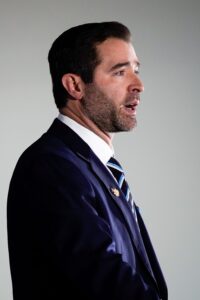 Vrabel operated as a CEO coach; Adams Strunk’s next hire will have more in-game control. The former Joe Burrow mentor will have his first chance to call plays this season, injecting some uncertainty into the Titans’ proceedings. But they have one of the architects of a quality NFL turnaround. Adams Strunk will hope hiring Callahan, 40, will unlock some levels for a scuffling offense. Taylor being able to retain his coordinators (Callahan, Lou Anarumo) for five seasons was interesting given the team’s resurgence, but after being on the interview circuit for a bit, Callahan will get to work on what looks like a more difficult project, with Levis nowhere near the level of prospect Burrow was.
Vrabel operated as a CEO coach; Adams Strunk’s next hire will have more in-game control. The former Joe Burrow mentor will have his first chance to call plays this season, injecting some uncertainty into the Titans’ proceedings. But they have one of the architects of a quality NFL turnaround. Adams Strunk will hope hiring Callahan, 40, will unlock some levels for a scuffling offense. Taylor being able to retain his coordinators (Callahan, Lou Anarumo) for five seasons was interesting given the team’s resurgence, but after being on the interview circuit for a bit, Callahan will get to work on what looks like a more difficult project, with Levis nowhere near the level of prospect Burrow was.
Wilson stands as the team’s top assistant. This gig comes a year after the Eagles passed over their secondary coach for DC, leading him to Baltimore. Mike Macdonald parlayed the Ravens’ No. 1-ranked defense into an HC job; three of his lieutenants — Wilson, Zach Orr and Anthony Weaver — landed DC positions. A DBs coach since 2015, Wilson paid his dues and will have a shot to be the top defensive voice in a team’s building. Meanwhile, Callahan’s play-calling role will limit Holz’s reach.
Wilson, 42, has a history with Carthon; both were in the Rams organization from 2015-16. Wilson then spent time with the Jets and Eagles, the second of his Philadelphia seasons a Super Bowl campaign. He then helmed Kyle Hamilton to an All-Pro season and Geno Stone to a breakout year.
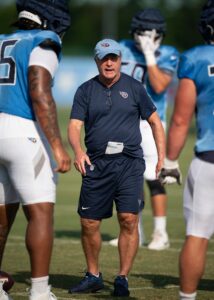 Holz, 40, has traveled a less conventional path. He bounced between the quality control level and assistant wide receivers coach with the Raiders from 2012-21. After a year as UNLV’s OC, Holz reentered the NFL as the Jags’ pass-game coordinator. Not present for Trevor Lawrence‘s late-season surge in 2022, Holz instead rode an uneven Jags 2023 season into this gig. This hire did not garner much attention, but Holz’s lack of experience as an NFL position coach is notable.
Holz, 40, has traveled a less conventional path. He bounced between the quality control level and assistant wide receivers coach with the Raiders from 2012-21. After a year as UNLV’s OC, Holz reentered the NFL as the Jags’ pass-game coordinator. Not present for Trevor Lawrence‘s late-season surge in 2022, Holz instead rode an uneven Jags 2023 season into this gig. This hire did not garner much attention, but Holz’s lack of experience as an NFL position coach is notable.
Dot-connecting made predicting the next Titans O-line coach rather easy, though it took the Browns letting Bill Callahan out of his contract to make a reunion with his son possible. The Callahans have never coached on the same staff previously. One of the game’s best O-line coaches, Bill Callahan helped turn the Browns’ front into an elite unit and will now take over the development of first-rounders Peter Skoronski and JC Latham. This will mark a pivotal chapter for the former Raiders HC, who is now 68.
Trades:
- Acquired franchise-tagged CB L’Jarius Sneed, No. 252 from Chiefs in exchange for No. 221, 2025 third-round pick; agreed to terms with CB on four-year, $76.4MM extension ($51.5MM guaranteed)
- Obtained OL Leroy Watson from Browns for No. 227
Several teams checked on Sneed, whom the Chiefs allowed to seek a trade upon franchise-tagging him. Keeping with its Andy Reid-era approach of not extending or re-signing cornerbacks, Kansas City prioritized a Chris Jones windfall over a Sneed re-signing. Despite Sneed enjoying a borderline dominant contract year, the Chiefs were unable to land too much. The prospect of a team then needing to extend the former fourth-round pick at a high rate dented the trade value, though the team did ultimately collect a Day 2 pick for a player it counted on as a starter during both Super Bowl-winning seasons.
 The report of the trade being finalized came shortly after a separate assessment indicating the Titans had cooled on Sneed. Tennessee was indeed one of the initial suitors, being aggressive here despite having given Chidobe Awuzie a hefty contract two weeks earlier. The Sneed deal came after the Titans had met with Tre’Davious White, who ended up with the Rams. The Titans’ early-round CB investments under Robinson either left in free agency after inconsistent tenures (Adoree’ Jackson, Kristian Fulton) or have seen injuries harpoon their careers (Caleb Farley). Carthon decided to start fresh, adding two new boundary starters in March.
The report of the trade being finalized came shortly after a separate assessment indicating the Titans had cooled on Sneed. Tennessee was indeed one of the initial suitors, being aggressive here despite having given Chidobe Awuzie a hefty contract two weeks earlier. The Sneed deal came after the Titans had met with Tre’Davious White, who ended up with the Rams. The Titans’ early-round CB investments under Robinson either left in free agency after inconsistent tenures (Adoree’ Jackson, Kristian Fulton) or have seen injuries harpoon their careers (Caleb Farley). Carthon decided to start fresh, adding two new boundary starters in March.
One of the Chiefs’ run of CB discoveries under Steve Spagnuolo, Sneed allowed just a 51% completion rate as the closest defender (at 4.8 yards per target) and a 56.2 passer rating. The Louisiana Tech alum did not yield a touchdown last season, playing an elite level for a Chiefs team suddenly unable to rely on its star-studded offense. Sneed’s advanced coverage numbers were not as flashy during his 2021 and ’22 starter slates, but he might be the top CB find during the Chiefs’ Reid era.
The Titans rewarded the 27-year-old defender with the highest guarantee at signing among corners. Sneed’s guarantee checks in $7MM north of the next-closest CB, but his AAV ($19.1MM) sits eighth. Sneed did well to secure guarantees into Year 3, which will make it difficult for the Titans to get off this contract — should the versatile DB not pan out in Nashville — until 2027. With experience outside and in the slot, Sneed gives the Titans options. Sneed will probably stick on the boundary considering the season he just put together in that role, with former second-rounder Roger McCreary still in place in the slot.
Free agency additions:
- Calvin Ridley, WR. Four years, $92MM ($46.98MM guaranteed)
- Lloyd Cushenberry, C. Four years, $50MM ($26MM guaranteed)
- Chidobe Awuzie, CB. Three years, $36MM ($19MM guaranteed)
- Tony Pollard, RB. Three years, $21.75MM ($10.49MM guaranteed)
- Kenneth Murray, LB. Two years, $15.5MM ($7.49MM guaranteed)
- Sebastian Joseph-Day, DL. One year, $4MM ($3.58MM guaranteed)
- Quandre Diggs, S. One year, $3MM ($2.75MM guaranteed)
- Mason Rudolph, QB. One year, $2.87MM ($2.7MM guaranteed)
- Tyler Boyd, WR. One year, $2.4MM ($1.2MM guaranteed)
- Jamal Adams, S. One year, $1.29MM ($1.15MM guaranteed)
- Geron Christian, T. One year, $1.25MM ($250K guaranteed)
- Nick Vannett, TE. One year, $1.21MM
 Knowing he had a rookie-scale QB contract to build around, Carthon proceeded to increase the talent level — no matter the cost — by adding the top players at multiple positions. Overpays may well be present among this class, but the Titans had seen many of their starters become unreliable in recent years — due largely to injuries. Although Levis is far from a sure thing, the Titans’ free agency plan is dependent on the rookie making strides and this contract complementing FAs’ guaranteed salaries over the next two years.
Knowing he had a rookie-scale QB contract to build around, Carthon proceeded to increase the talent level — no matter the cost — by adding the top players at multiple positions. Overpays may well be present among this class, but the Titans had seen many of their starters become unreliable in recent years — due largely to injuries. Although Levis is far from a sure thing, the Titans’ free agency plan is dependent on the rookie making strides and this contract complementing FAs’ guaranteed salaries over the next two years.
Ridley was not the first of the free agents to sign, but his contract generated the most attention. Lurking as a Jaguars-Patriots duel formed for the former first-rounder’s services, the Titans came in with a deal that surprised many. With Mike Evans re-signing with the Buccaneers before free agency and the Colts tagging Michael Pittman Jr., WR-needy teams spent. The Gabe Davis and Darnell Mooney $13MM-per-year contracts illustrate that.
The Titans were determined to pay up for a more proven commodity, though Ridley’s age and inconsistent past somewhat undercuts his two 1,000-yard seasons. That did not end up mattering in this market; Ridley secured the fourth-most guaranteed money at signing among WRs.
Leaving the Falcons for mental health reasons early during the 2021 season, Ridley then incurred a full-season gambling suspension. This drained a chunk of his prime, and although he has only finished four NFL seasons, the 2018 first-rounder will turn 30 this year. The Titans only guaranteed two of Ridley’s base salaries, which will make a 2026 escape doable in the event this is indeed a regrettable overpay.
With DeAndre Hopkins again battling knee trouble, the Titans need Ridley to build on the 1,016-yard showing he delivered last season in Jacksonville. Ridley working out also would provide the Titans a bonus, as it cost the Jags third- and fifth-round picks to secure one season of the veteran wideout. For a Titans team having some experience with bad receiver decisions this decade (Julio Jones, A.J. Brown), this is certainly a gamble. But a case can also be made Ridley has room for growth after posting a 1,000-yard year following effectively two missed seasons.
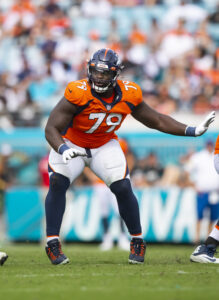 Cushenberry represents another swing. Not viewed as a Broncos strength for the first three seasons of his starter run, the former third-round center took a well-timed step forward. Joining Ridley in the top 20 of PFR’s free agent list, Cushenberry ranked 11th among interior O-linemen in pass block win rate last season. As other centers in recent free agency periods settled for midlevel money, Cushenberry drew a market that settled with him as the second-highest-paid snapper (in terms of AAV and full guarantees).
Cushenberry represents another swing. Not viewed as a Broncos strength for the first three seasons of his starter run, the former third-round center took a well-timed step forward. Joining Ridley in the top 20 of PFR’s free agent list, Cushenberry ranked 11th among interior O-linemen in pass block win rate last season. As other centers in recent free agency periods settled for midlevel money, Cushenberry drew a market that settled with him as the second-highest-paid snapper (in terms of AAV and full guarantees).
After cutting longtime starter Ben Jones, the Titans used former UDFA Aaron Brewer at center last season. They will bet on Cushenberry’s contract year, as he commanded a far more lucrative deal than any Jones signed. The John Elway-era draftee joined Ridley in being among the top beneficiaries from this year’s cap spike.
It would appear Pollard’s skillset overlaps with Tyjae Spears‘; that looks to have been somwehat by design. Rather than attempt to recreate a thunder-lighting duo by trying to replicate Henry’s old-school skillset, Carthon and Co. added a second shifty back. The franchise tag hurt Pollard’s value considerably, as he almost definitely would have scored more guaranteed money had the Cowboys let him test free agency in 2023. With Dallas attempting to use the former fourth-round pick as a true Ezekiel Elliott replacement, Pollard was less effective.
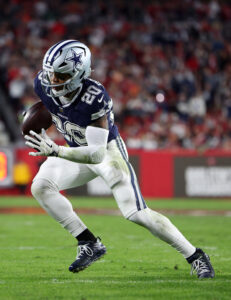 Amassing 1,378 scrimmage yards, 12 touchdowns and a 9.5-yard average per catch, Pollard ranked third in Next Gen Stats’ rushing yards over expected metric (226) in 2022. Given 75 more touches last season, Pollard produced fewer scrimmage yards (1,316) and saw his yards-per-carry number crater from 5.2 to 4.0 despite Dallas rolling out a three-All-Pro O-line. The 2022 Pro Bowler will be paired with Spears, setting up an interesting timeshare. Pollard, 27, still only has 938 career touches on his odometer. The team presumably hopes a usage decrease rejuvenates the elusive runner.
Amassing 1,378 scrimmage yards, 12 touchdowns and a 9.5-yard average per catch, Pollard ranked third in Next Gen Stats’ rushing yards over expected metric (226) in 2022. Given 75 more touches last season, Pollard produced fewer scrimmage yards (1,316) and saw his yards-per-carry number crater from 5.2 to 4.0 despite Dallas rolling out a three-All-Pro O-line. The 2022 Pro Bowler will be paired with Spears, setting up an interesting timeshare. Pollard, 27, still only has 938 career touches on his odometer. The team presumably hopes a usage decrease rejuvenates the elusive runner.
On a market in which Kendall Fuller scored only a two-year, $15MM deal, Awuzie did incredibly well. Some CBs angling for third contracts populated the upper reaches of year’s free agent class, and Awuzie topped them all for AAV and guarantees. This was a bit surprising, as the three-year Bengal suffered a torn ACL in 2022 and was benched for part of last season. Awuzie, 29, did re-emerge to play at least 97% of the Bengals’ snaps in five of the team’s final six games. The Titans are making a big bet on the former Cowboys second-rounder regaining his pre-ACL-tear form, though he will be nearly two years removed from the injury when he debuts for his third NFL team.
Making it known they were in on a buyer’s market at safety, the Titans added both starters the Seahawks cut, doing so after hosting ex-Adams teammate Marcus Maye. Adams is more linebacker than safety at this point — the Seahawks actually asked him to switch — due to his coverage limitations and his pass-rushing skills. Adams did not come close to living up to a then-record extension, and injuries have dogged the former top-10 pick over the past two years.
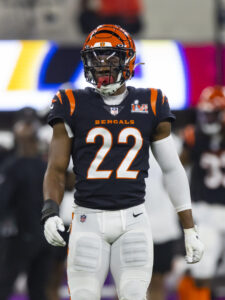 Diggs is better in coverage and was far more durable in Seattle, starting every game over the past four seasons. The former Lions regular booked three Pro Bowl nods in Seattle. Although Diggs is nearly three years older than Adams, at 31, he is probably the better bet to excel based on his recent availability and performance as a traditional safety. The duo joins holdover Amani Hooker, with the Titans splitting up the long-running Hooker-Kevin Byard pair before the trade deadline.
Diggs is better in coverage and was far more durable in Seattle, starting every game over the past four seasons. The former Lions regular booked three Pro Bowl nods in Seattle. Although Diggs is nearly three years older than Adams, at 31, he is probably the better bet to excel based on his recent availability and performance as a traditional safety. The duo joins holdover Amani Hooker, with the Titans splitting up the long-running Hooker-Kevin Byard pair before the trade deadline.
Boyd, 29, rounds out a three-veteran first-string WR corps. The eight-year Bengals slot followed Callahan to Tennessee — eventually, as he was connected to several teams. The Chargers brought Boyd in for a meeting, and the Titans met with Zay Jones as well. They added Boyd as a big slot. Boyd was part of one of this era’s best wideout trios, clearing 800 receiving yards in four straight seasons (2018-21) and surpassing 650 in each of the past two alongside Ja’Marr Chase and Tee Higgins. Boyd may be in decline, ranking just inside the top 100 among wideouts ESPN’s open score metric last season (though, he was 52nd in 2022). But he is familiar with Callahan’s system and came cheap.
Rudolph shepherding the Steelers to another playoff berth did not produce much of a market. Entering last season as Pittsburgh’s third-stringer, Rudolph drew a low-end deal — even by QB2 standards. Marcus Mariota doubled his contract, while Drew Lock nearly did so. Completing 74.3% of his passes and going 3-0 as a starter last season, Rudolph was more willing to target George Pickens downfield (9.7 yards per attempt), compared to Kenny Pickett, to boost Pittsburgh back to the postseason.
 As should be expected, Rudolph is ahead of Malik Willis in the Titans’ QB2 matchup. Tennessee has pondered carrying three QBs, but neither of the team’s primary decision-makers were present when Willis went off the 2022 draft board in Round 3. The once-highly regarded (by draft experts, not so much by teams) prospect seems out of place — given Levis’ status — on this roster.
As should be expected, Rudolph is ahead of Malik Willis in the Titans’ QB2 matchup. Tennessee has pondered carrying three QBs, but neither of the team’s primary decision-makers were present when Willis went off the 2022 draft board in Round 3. The once-highly regarded (by draft experts, not so much by teams) prospect seems out of place — given Levis’ status — on this roster.
A year after ex-49ers Azeez Al-Shaair and Daniel Brunskill joined Tennessee, Carthon showed interest in reuniting with Arik Armstead. It instead took a significant guarantee ($28MM) for Jaguars GM Trent Baalke, who drafted Armstead in the 2015 first round, to land the talented but injury-prone inside rusher. Joseph-Day possesses a different skillset, being more of a run stuffer. Despite the Chargers cutting the veteran, he totaled a career-most 11 tackles for loss last year.
Re-signings:
- Nick Folk, K. One year, $3.76MM ($3.5MM guaranteed)
- Morgan Cox, LS. One year, $1.38MM ($1.15MM guaranteed)
- Nick Westbrook-Ikhine, WR. One year, $2MM ($750K guaranteed)
- Corey Levin, OL. One year, $1.13MM
- Marlon Davidson, DL. One year, $1.1MM
At 39 and 38, Folk and Cox are two of the oldest active NFLers. Acquired via trade just before last season, Folk led the NFL with a 96.7% make rate. This included a 5-for-6 mark from 50-plus yards and 6-for-6 from 40-49. Folk proved to be a good investment, as a short-term play at least, after the Titans dealt with extensive kicker inconsistency (11 saw action from 2019-22) in recent years.
Notable losses:
- Azeez Al-Shaair, LB
- Denico Autry, DL
- Ross Blacklock, DL
- Aaron Brewer, OL
- Saahdiq Charles, G (retired)
- Andre Dillard, T (released)
- Kristian Fulton, CB
- Terrell Edmunds, S
- Trevis Gipson, OLB
- Derrick Henry, RB
- Chris Hubbard, T
- Jaleel Johnson, DL
- Joseph Jones, LB
- Chris Moore, WR
- Sean Murphy-Bunting, CB
- Kyle Peko, DT
- Ryan Tannehill, QB
- Calvin Throckmorton, OL
- K’Von Wallace, CB
- Trevon Wesco, TE
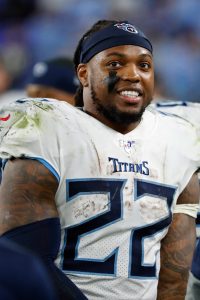 Steve McNair might be the greatest Titan, even though the former MVP began his career as an Oiler. In terms of Titan-only performers, it is difficult to argue against Henry. The bar should be different for running backs in terms of Hall of Fame entry based on this era, which should give the bulldozing runner a chance despite his current placement on the all-time rushing yardage list (36th). Henry rampaged for five 1,000-yard seasons and won two rushing titles. Even as RB value declines, Henry served as the centerpiece player for three Vrabel-era playoff teams and did the most to drive the 2019 edition to the AFC title game.
Steve McNair might be the greatest Titan, even though the former MVP began his career as an Oiler. In terms of Titan-only performers, it is difficult to argue against Henry. The bar should be different for running backs in terms of Hall of Fame entry based on this era, which should give the bulldozing runner a chance despite his current placement on the all-time rushing yardage list (36th). Henry rampaged for five 1,000-yard seasons and won two rushing titles. Even as RB value declines, Henry served as the centerpiece player for three Vrabel-era playoff teams and did the most to drive the 2019 edition to the AFC title game.
The topic of RB extensions became a macro issue once again recently, but the Titans benefited from their four-year, $50MM Henry extension at the July 2020 franchise tag deadline. He won a second straight rushing title, rambling for 2,027 yards in 2020. After a 2021 foot injury, the former Heisman winner ripped off two more 1,000-yard years. Henry has led the NFL in carries in four of the past five seasons, and his 2,185 career touches trail only Ezekiel Elliott among active backs.
It is understandable the Titans, at this point on their timeline, passed on a third Henry deal. The Ravens are taking a bit of a gamble, but their two-year, $16MM agreement is effectively a one-year commitment for the 30-year-old back. Carthon denied a report he was overruled on a 2023 Henry trade, but the sides still parted ways after one of this century’s most successful RB partnerships.
The 2020 offseason installed Henry and Tannehill as the Titans’ pillars, but after the latter’s Marcus Mariota replacement effort keyed a run to the conference championship (featuring a top-10 yards-per-attempt figure — 9.6 — in NFL history), this extension did not pan out as well as Henry’s. Tannehill’s four-year, $118MM re-up became a mid-market deal during its lifespan, but after the former Dolphins first-rounder bucked his injury trouble during 2020 and ’21 Titans playoff seasons, he missed time in 2022 and ’23 due to maladies.
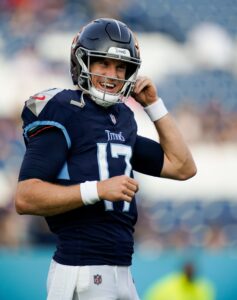 Tennessee ended Tannehill’s four-year starter run midway through last season, and the 36-year-old passer has not shown a strong desire to play this year. Tennessee nevertheless did well on the 2019 Tannehill trade, which cost only fourth- and seventh-round picks. It unlocked a level for Vrabel’s team Mariota could not, but the Levis investment signaled the club was moving on.
Tennessee ended Tannehill’s four-year starter run midway through last season, and the 36-year-old passer has not shown a strong desire to play this year. Tennessee nevertheless did well on the 2019 Tannehill trade, which cost only fourth- and seventh-round picks. It unlocked a level for Vrabel’s team Mariota could not, but the Levis investment signaled the club was moving on.
Autry continues to play well into his 30s, and Al-Shaair capitalized on his “prove it” Tennessee deal. Both players ended up in Houston, with Al-Shaair reuniting — via a three-year, $34MM deal ($21.5MM guaranteed) — with DeMeco Ryans. Al-Shaair recorded the most tackles (163) by a Titan since the franchise relocated. Kenneth Murray generated a somewhat surprising market, given the first-rounder’s underwhelming Chargers tenure that included a benching and limited usage before a somewhat promising contract year (albeit one PFF still ranked 76th among LBs). And the Texans made Al-Shaair one of the NFL’s highest-paid non-rush ‘backers.
Providing strong supporting work alongside Jeffery Simmons and Harold Landry, Autry offered consistency (eight-plus sacks in three straight years) and versatility in Tennessee. Though, the Titans passed on paying for the veteran D-lineman’s age-34 and age-35 seasons, leading him to a two-year Texans agreement.
Charles signed a one-year, $1.5MM deal and was competing with Dillon Radunz for the team’s right guard job. Just 25, he left the team early in training camp. This gives Radunz a good shot at a contract-year starting gig, but the Titans were certainly surprised by the ex-Commanders starter bolting. Bill Callahan said he has not heard back from the since-retired blocker.
Draft:
- Round 1, No. 7: JC Latham (T, Alabama) (signed)
- Round 2, No. 38: T’Vondre Sweat (DT, Texas) (signed)
- Round 4, No. 106: Cedric Gray (LB, North Carolina) (signed)
- Round 5, No. 146 (from Vikings through Eagles): Jarvis Brownlee Jr. (CB, Louisville) (signed)
- Round 6, No. 182 (reacquired through Eagles): Jha’Quan Jackson (WR, Tulane) (signed)
- Round 7, No. 242 (from Eagles): James Williams (S, Miami) (signed)
- Round 7, No. 252 (from Chiefs): Jaylen Harrell (EDGE, Michigan) (signed)
Perhaps more so than the Chargers, Titans rumors connected them squarely to an O-line investment in Round 1. The team brought in Joe Alt for a visit and showed interest in the two-time All-American, but the Chargers eschewed their receiver need to draft the Notre Dame standout. Shortly before the draft, however, Titans-Latham connections surfaced. With the Bolts removing Alt from the equation, the Titans did not overthink their decision.
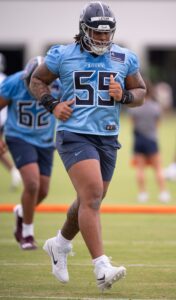 A fourth of this year’s first round produced tackle picks, and six of those blockers are changing positions. Latham is among them, as the Titans moved the Alabama right tackle to the left side. He earned second-team All-America acclaim last season, becoming the latest in a long line of Crimson Tide tackles drafted early. The Titans admitted a mistake on their three-year, $29MM Andre Dillard signing early, benching the former first-rounder and then cutting him.
A fourth of this year’s first round produced tackle picks, and six of those blockers are changing positions. Latham is among them, as the Titans moved the Alabama right tackle to the left side. He earned second-team All-America acclaim last season, becoming the latest in a long line of Crimson Tide tackles drafted early. The Titans admitted a mistake on their three-year, $29MM Andre Dillard signing early, benching the former first-rounder and then cutting him.
Latham continues the team’s overhaul on offense. Only three Robinson-era draftees (Radunz, Nicholas Petit-Frere, TE Chig Okonkwo) are in line to start on offense. Despite this being only Carthon’s second year, he has reshaped the unit. Considering PFF ranked the Titans’ O-line 32nd in 2023, the team prioritizing it via the Latham pick, Cushenberry signing and Bill Callahan hire certainly add up.
The 2023 Big 12 Defensive Player of the Year, Sweat will be asked to help replace Autry and form an eventual tandem with Simmons. Sweat fell outside of Daniel Jeremiah’s NFL.com top 50, but in teaming with first-rounder Byron Murphy, the 366-pound anchor managed to be named the Big 12’s top defender despite being light on stats (two sacks, four pass deflections, eight TFLs). But he made a significant impact on the Longhorns’ defense, even with Murphy being chosen 22 picks earlier. The surprisingly nimble defender, who did receive a DWI charge this offseason, could soon be a handful for interior O-linemen.
Other:
- Declined CB Caleb Farley‘s $12.47MM fifth-year option
- OLB Arden Key facing six-game PED suspension
- Signed 16 UDFAs
Farley played a not insignificant role in Robinson’s 2022 firing, as the GM saw many of his acquisitions struggle to stay healthy. Farley, who came to Tennessee with a notable injury past, was a lead cast member here. The Titans chose the talented corner 22nd overall, doing so despite the cover man tearing an ACL and undergoing two back surgeries before his rookie season, and have seen him play in only 12 of a possible 52 games. After suffering a torn ACL as a rookie, Farley ran into more back trouble in 2022. Bowen benched him early that season, and more injury complications ensued to force a full-season 2023 absence.
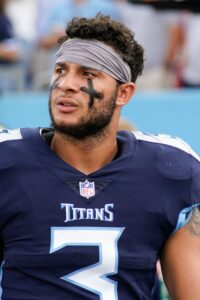 Robinson hit on Simmons, who fell due to a pre-draft injury, but missed wildly on Farley and 2020 first-rounder Isaiah Wilson. The latter, he of four career snaps, is among the biggest busts in NFL history. Farley has not done much more, and he is again dealing with injury trouble — this time a hamstring issue — in training camp. With no ties to the current Tennessee regime, Farley may well lose his roster spot soon. The Titans have obviously spent big to cover for past CB missteps.
Robinson hit on Simmons, who fell due to a pre-draft injury, but missed wildly on Farley and 2020 first-rounder Isaiah Wilson. The latter, he of four career snaps, is among the biggest busts in NFL history. Farley has not done much more, and he is again dealing with injury trouble — this time a hamstring issue — in training camp. With no ties to the current Tennessee regime, Farley may well lose his roster spot soon. The Titans have obviously spent big to cover for past CB missteps.
Brian Callahan has acknowledged the Key suspension, which will once again leave the Titans shorthanded on the edge. Key signed a three-year, $24MM deal to complement Landry, as the Titans have experienced a difficult time staffing their OLB2 post. This became a major issue when Landry missed the 2022 season. Key produced six sacks last season. Behind him, the Titans have veteran Rashad Weaver, who racked up 5.5 sacks during Landry’s full-season absence. He did not record any last season. It would not surprise to see Tennessee make a move here before Week 1. Yannick Ngakoue remains available.
Top 10 cap charges for 2024:
- Harold Landry, OLB: $23.8MM
- Jeffery Simmons, DL: $21.65MM
- DeAndre Hopkins, WR: $18.31MM
- Calvin Ridley, WR: $10MM
- L’Jarius Sneed, CB: $9.96MM
- Amani Hooker, S: $9.32MM
- Chidobe Awuzie, CB: $6.94MM
- Lloyd Cushenberry, C: $6.43MM
- Kenneth Murray, LB: $5.44MM
- JC Latham, T: $4.74MM
Vrabel’s inability to land a job aside, the Titans are taking a chance by moving on. Behind-the-scenes trouble will lead to a Carthon-Callahan partnership leading the way, and after Vrabel held a key voice in decision-making matters between Robinson’s firing and his own, the 2024 season will present a clearer picture of Carthon’s blueprint. Adams Strunk’s reach is quite clear now as well. Levis not showing immediate improvement, considering what Carthon has put into the offense this offseason, will bring concerns early in the ex-49ers exec’s tenure.
Conversely, Levis development would give the Titans a rare asset — a second-round QB centerpiece. In a division now featuring three top-four QB draftees, Levis may continue to fly under the radar. Even if the Titans are not a 2024 playoff team, their season will be judged on the Kentucky prospect showing growth around a new-look receiving corps and a bolstered offensive line.
Hoping Callahan does great in his first head coaching gig. Never got to see his full potential because Zac Taylor called the plays. I think Taylor fancies himself as a offensive genius (cough bull*hi* cough). Callahan has got the makings of a pretty good team and I for one hope he succeeds.
Lots of turnover on the roster and with coaches. Lots of FAs and draft picks. All behind a raw QB. Always thought Vrabel was a good coach who had his players play tough and grind out games, but he just isn’t the HC to get you up to the next level. Don’t have alot of expectations this season for them.
These days you couldn’t have a coach like Forrest Gregg. Can’t toughen these guys up because they’ll cry, or go see the team shrink because the coach was mean to them. “Sorry Coach, we’ve had to put Mr Mims (6’8, 370 lbs) on injured reserve because he was bullied by you and your other coaches,” Says Dr Patel,the Bengals team psychiatrist.
Solid 6 win team
Amy Adams will do for the Titans what Mark Davis has done for the Raiders.
Wow, talk about an owner grinding a successful organisation into dust. Vrabel hasn’t been rehired yet, as most GM’s aren’t up to the task. If Vrabel doesn’t have a drinking problem (as a player he used to carry a whiskey flask in New England, where it’s cold), he will make another struggling organisation a playoff regular.